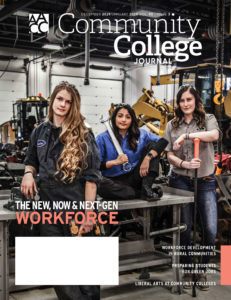Bellevue College President Jerry Weber knew that many of his students were passionate about the environment. A student-run environmental fund collects money each quarter to support campus sustainability projects, and an academic concentration in sustainability has proven to be quite popular as well.
But even Weber was surprised by the turnout during a Walkout for Climate Justice on campus in September. More than 300 students and faculty took part in the college’s effort to call attention to the urgent need for action on global climate change.
This excerpt comes from an article in the current issue of AACC’s Community College Journal.
“Today’s students are coming of age with an understanding of the impact that climate change might have on their lives,” Weber says. “They are aware more carbon is being loaded into the atmosphere, and they want to do something about it.”
A lot at the numbers
“Green” jobs that contribute to preserving the environment are among the fastest-growing careers in the U.S., according to the Bureau of Labor Statistics. With the rising need for workers to fill these positions, and surging interest among students in environmental careers, community colleges are creating new courses, certifications and degree programs to meet the demand.
Because they’re adept at identifying the needs in their area and quickly fashioning programs to meet those needs, “community colleges are the perfect venue for training people for these jobs,” says Kirk Laflin, executive director of the National Partnership for Environmental Technology Education (PETE).
It’s not just curricula that are changing. Colleges are changing their practices as well. They’re hiring sustainability managers, applying energy-saving measures and taking a leadership role in educating their communities about the importance of sustainability.
Renewable energies are in high demand. According to the 2019 U.S. Energy and Employment Report, a joint project of the National Association of State Energy Officials and the Energy Futures Initiative, the number of jobs in the United States that involve solar and wind power (353,509) now far outnumber those involving fossil fuels such as coal, oil and natural gas (198,887).
U.S. Labor Department data suggest that the two occupations projected to have the fastest growth through 2026 are solar photovoltaic installers and wind turbine service technicians. Laflin believes the demand for wastewater treatment workers over the next decade will be high as well.
“Wastewater technicians operate behind the scenes, and we tend to take their work for granted,” he says. “When you turn on the tap and get water, you don’t think about how it’s delivered. While the Clean Water Act of 1972 created a host of new jobs, we’re now seeing the impact of retirements in this area.”
Related article: Filling the pipeline for water tech jobs
Illinois added about 1,300 solar jobs in 2018, bringing the state’s total to nearly 5,000, says John Brophy, director of environmental technology programs for City Colleges of Chicago (CCC). Not surprisingly, he says, wind power is a significant source of jobs in the area as well, with 14 wind energy companies located in the Windy City. To meet the needs of these employers, CCC’s Wilbur Wright College offers an associate of applied science degree in environmental technology and a six-course certification building energy technologies program.
One of the challenges in creating programs to meet these needs is that the technologies involved are changing rapidly.
“The industry is in such flux that I can’t keep a textbook,” says Brophy, who teaches a renewable energies course. “Just this year, five of the 15 coal plants in the state announced closings. Even solar energy technologies have changed so much in the last 10 years. The change is happening in real time.”
Because Brophy has struggled to find a textbook that is current enough for his renewable energies course, he relies on guest speakers, such as executives from local wind and solar companies.
“We’re turning to the experts for instruction,” he says.
Beyond renewable energy positions
Wright College’s building energy technologies certificate is designed to help students incorporate sustainability and energy efficiency concepts into the construction, renovation, and operation of buildings. This certification and the environmental technology degree aren’t the only opportunities for CCC students to prepare for green jobs. For instance, the AAS program in air conditioning and refrigeration at CCC’s Kennedy-King College includes information on high-efficiency furnaces, and the institution’s auto maintenance programs cover hybrid and alternative-fuel vehicles.

Read the current issue of Community College Journal online.
“Our goal isn’t to have one single program where students can prepare for sustainable jobs,” Brophy says. “It’s to make all of our programs greener in response to this trend.”
This is an important approach for leaders to consider as they aim to prepare students for green jobs, says Debra Rowe, president of the U.S. Partnership for Education for Sustainable Development and a faculty member who teaches about sustainable technologies at Michigan’s Oakland Community College (OCC).
Green jobs go well beyond the renewable energy positions that many people associate with this term, she says. Any job in which employees are making strategic decisions about what resources to consume are considered green jobs. This might include business managers who want to go green or make their product lines more sustainable, as well as building design and construction firms, policymakers, and so on.
OCC has been integrating green design principles into its technical education programs for decades. Students can’t receive a degree or certification in heating and cooling technologies without taking a course in energy management, and they must complete a commercial and a residential energy audit as a final project.
At community colleges nationwide, culinary arts programs are teaching students how to avoid pesticides and choose locally produced ingredients and sustainable fishes. Landscaping programs are teaching about environmentally sound practices such as permaculture and how to grow low-maintenance lawns.
“You can look at any job through a sustainability lens,” Rowe says.

